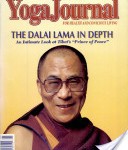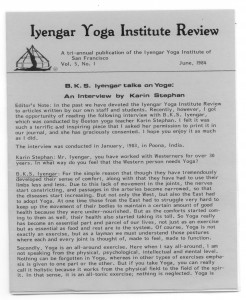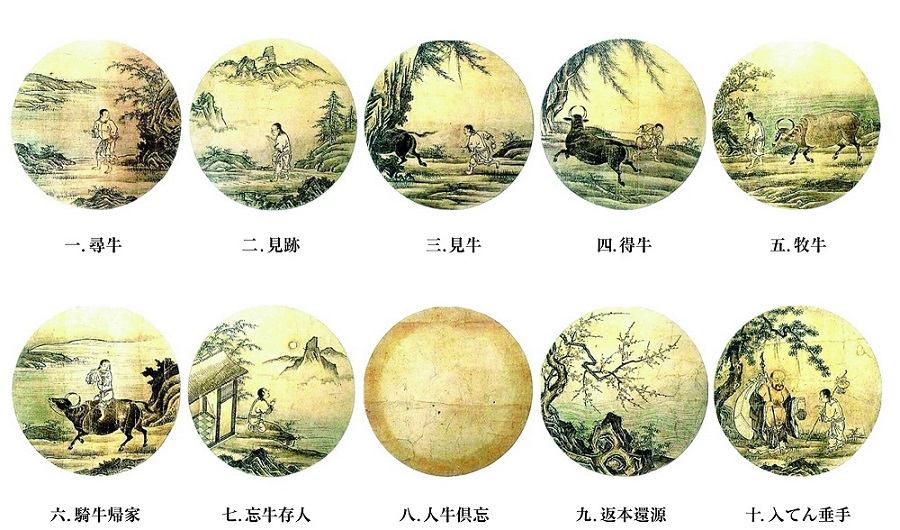When I arrived in San Francisco in 1979, the Yoga Journal was still in its infancy and the yoga scene was also quite young. Writers were needed to help get yoga practice out into the world and I volunteered. This is most of the output from those days, but there are still a few missing pieces from early IYI Reviews that I am trying to track down. I have scanned the ones here from either the originals, or copies I have managed to retain, so please excuse the quality. For several others, you are linked directly to the whole magazine where you will have to search a bit. If you google  ‘Yoga Journal, 1990’, you can find complete issues with pdf’s of the asana column series with much better quality than I have here. If you dig more deeply into the google store archives, you will find many more excellent articles on yoga by Judith Lasater, Donald Moyer, Carol Cavanaugh, Linda Cogozzo and Dona Farhi.
‘Yoga Journal, 1990’, you can find complete issues with pdf’s of the asana column series with much better quality than I have here. If you dig more deeply into the google store archives, you will find many more excellent articles on yoga by Judith Lasater, Donald Moyer, Carol Cavanaugh, Linda Cogozzo and Dona Farhi.
The American Yoga Newsletter, (AYN), the brainchild of dear friend and now co-publisher of Rodmell Press, Linda Cogozzo, was published by the Yoga Journal, (YJ), from 1983 to 1985.
Linda was the assistant editor at the Yoga Journal for most of the 1980’s when I was in my peak writing phase. We were often co-conspirators in trying to keep ‘yoga’ in the Yoga Journal, as Stephen Bodian, the editor in chief, was more Buddhist in his practice. But for the 80’s anyway, it was America’s foremost spiritual magazine.
The IYI Review, (IYIR), was the newsletter of the Iyengar Yoga Institute of San Francisco published in the 1980’s. Carol Cavanaugh began as editor in 1980 and I took over sometime in the mid 80’s. The first major article I wrote was ‘Awakening the Intelligence of the Body’, in 1983. It is a bit convoluted, but shows my early attempts to make sense of the energy body. The first two pages did not scan well, so I retyped them.
I wrote the Asana Column for the Yoga Journal Magazine in 1990. It was a fun exercise in choosing key poses to highlight the main principles in asana practice. (You may recognize the lovely model who helped out in presenting the material.) I also was able to weave in some of the Cosmic dimensions that were coming from my work with Thomas Berry and Brian Swimme. Soon after this, we would leave the Bay Area for Boston, and between opening Mystic River Yoga and starting a family, the time and energy for writing stopped. Only in the last few years have I begun to write again, with the blog being my outlet.
Yoga: An Antidote to Stress: YJ, October 1982
Dona Holleman: Teacher of Teachers: YJ, October 1982
Starting a Pranayama Practice: YJ, March/April 1983
Yoga for Asthma: YJ, May/June 1983
Understanding Twists: AYN, June, 1983
Awakening the Intelligence of the Body: IYIR, October 1983
Safe Practice of Inversions: YJ, November/December, 1983
Dona Holleman: AYN, December, 1983
Protecting the Knees: AYN, April, 1984
Understanding Twists: YJ, September/October 1984
Standing Your Ground: AYN, May, 1985
Developing Arm Stength in Asana: YJ, January/February 1986
Reflections on Pune: IYIR, March, 1987
Froggie Yoga (for hips and thighs): YJ, May/June 1989
Tadasana: YJ, January/February, 1990
Parivrtta Trikonasana: YJ, March/April 1990
Upavistha Konasana: YJ, May/June, 1990
Sirsasana: YJ, July/August 1990
Sarvangasana: YJ, September/October, 1990
Urdhva Dhanurasana: YJ, November/December, 1990



